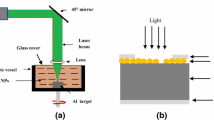Abstract
The generation of laser radiation by a solid active element based on a nanoporous aluminum oxide film activated with rhodamine 6G has been obtained for the first time in the geometry to reflection. The lasing is characterized by high-quality radiation with the absence of a spontaneous component. It is found that the application of silicone oil as the immersion substance reduces the generation threshold more than two times. The optimal concentration of rhodamine 6G molecules in the impregnation solution for mirror films of nanoporous aluminum oxide is determined, at which the dye fluorescence intensity has the maximum value. The generation by a nanoporous aluminum oxide film activated with rhodamine 6G in the continuous mode has been obtained for the first time.
Similar content being viewed by others

References
V. I. Zemskii, Yu. L. Kolesnikov, and I. K. Meshkovskii, Physics and Technology of Pulsed Dye Lasers (SPbGU ITMO, St. Petersburg, 2005) [in Russian].
W. Zhang, J. Yao, and Y. S. Zhao, “Organic micro/nanoscale lasers,” Acc. Chem. Res. 49, 1691–1700 (2016).
Y. J. Li, Y. Yan, Y. S. Zhao, and J. Yao, “Construction of nanowire heterojunctions: photonic function-oriented nanoarchitectonics,” Adv. Mater. 28, 1319–1326 (2016).
F. A. Bol’shchikov, E. A. Garibin, P. E. Gusev, A. A. Demidenko, M. V. Kruglova, M. A. Krutov, A. A. Lyapin, I. A. Mironov, V. V. Osiko, V. M. Reitirov, P. A. Ryabochkina, N. V. Sakharov, A. N. Smirnov, S. N. Ushakov, and P. P. Fedorov, “Nanostructured Tm:CaF2 ceramics: potential gain media for two micron lasers,” Quantum Electron. 41, 193 (2011).
H. W. Shin, S. Y. Cho, K. H. Choi, and Y. R. Kim, “Directional random lasing in dye-TiO2 doped polymer nanowire array embedded in porous alumina membrane,” Appl. Phys. Lett. 88, 263112 (2006).
A. Costel, I. Garcia-Moreno, D. del Agua, O. García, R. Sastre, “Highlyphotostable solid-state dye lasers based on silicon-modified organic matrices,” J. Appl. Phys. 101, 731–742 (2007).
S. J. Marinho, L. M. Jesus, L. B. Barbosa, D. R. Ardila, M. Alencar, and J. J. Rodrigues, “Bi-chromatic random laser from alumina porous ceramic infiltrated with rhodamine B,” Laser Phys. Lett. 12, 055801–055805 (2015).
A. Moadhen, H. Elhouichet, L. Nosova, and M. Oueslati, “Rhodamine B absorbed by anodic porous alumina: stokes and anti-stokes luminescence study,” J. Lumin. 126, 789–794 (2007).
Z. Li and K. Huang, “Optical properties of alumina membranes prepared by anodic oxidation process,” J. Lumin. 127, 435–440 (2007).
Z. L. Zhang, H. R. Zheng, J. Dong, X. Q. Yan, Y. Sun, and H. X. Xu, “Surface enhanced fluorescence by porous alumina with nanohole arrays,” Sci. China, Ser. G 55, 767–771 (2012).
N. Kh. Ibrayev, A. K. Zeinidenov, A. K. Aimukhanov, and K. S. Napolskii, “Stimulated emission from aluminium anode oxide films doped with rhodamine 6G,” Quantum Electron. 45, 663 (2015).
G. A. Lyubas, V. V. Shelkovnikov, and S. V. Korotaev, “Optical interferometric sensor based on thin layers of nanoporous anodized aluminum containing nanoparticles of noble metals,” Nanotechnol. Russ. 11, 29 (2016).
V. V. Shelkovnikov, G. A. Lyubas, and S. V. Korotaev, “Enhanced reflective interference spectra of nanoporous anodic alumina films by double electrochemical deposition of chemical metal nanoparticles,” Prot. Met. Phys. Chem. Surf. 52, 227 (2016).
V. V. Shelkovnikov, G. A. Lyubas, and S. V. Korotaev, “Controlled interference color of the metal surface by combination of the chemical and electrochemical aluminum surface treatment,” Nanosyst.: Phys., Chem., Math. 5, 718–727 (2014).
T. Kumeria, M. M. Rahman, A. Santos, J. Ferré-Borrull, L. F. Marsal, and D. Losic, “Structural and optical nanoengineering of nanoporous anodic alumina rugate filters for real-time and label-free biosensing applications,” Anal. Chem. 86, 1837–1844 (2014).
A. Santos, T. Kumeria, and D. Losic, “Nanoporous anodic alumina: a versatile platform for optical biosensors,” Materials 7, 4297–4320 (2014).
A. Santos, T. Kumeria, and D. Losic, “Optically optimized photoluminescent and interferometric biosensors base on nanoporous anodic alumina: a comparison,” Anal. Chem. 85, 7904–7911 (2013).
J. Ferré-Borrull, M. M. Rahman, J. Pallares, and L. F. Marsal, “Tuning nanoporous anodic alumina distributed- bragg reflectors with the number of anodization cycles and the anodization temperature,” Nanoscale Res. Lett. 9, 416–422 (2014).
J. Ferré-Borrull, J. Pallares, G. Macias, and L. F. Marsal, “Nanostructural engineering of nanoporous anodic alumina for biosensing applications,” Materials 7, 5225–5253 (2014).
G. Macias, L. P. Hernández-Eguía, J. Ferré-Borrull, J. Pallares, and L. F. Marsal, “Gold-coated ordered nanoporous anodic alumina bilayers for future labelfree interferometric biosensors,” ACS Appl. Mater. Interfaces 5, 8093–8098 (2013).
V. B. Tatarskii, Crystal Optics and the Immersion Method (Nedra, Moscow, 1965) [in Russian].
R. Barbosa-Silva, A. F. Silva, A. M. Brito-Silva, and C. B. de Araújo, “Bichromatic random laser from a powder of rhodamine-doped sub-micrometer silica particles,” J. Appl. Phys. 115, 043515 (2014).
P. Vaveliuk, A. M. de Brito-Silva, and P. C. de Oliveira, “Model for bichromatic laser emission from a laser dye with nanoparticle scatterers,” Phys. Rev. A 68, 013805 (2003).
M. A. F. de Souza, A. Lencina, and P. Vaveliuk, “Controlling bichromatic emission in scattering gain media,” Opt. Lett. 31, 1244–1246 (2006).
F. P. Schäfer, Dye Lasers (Springer, Berlin, 1990; Mir, Moscow, 1976).
O. Svelto, Principles of Lasers (Plenum, New York, 1976; Mir, Moscow, 1979).
Handbook of Laser Engineering, Ed. by A. P. Napartovich (Energoatomizdat, Moscow, 1991) [in Russian].
Author information
Authors and Affiliations
Corresponding author
Additional information
Original Russian Text © G.A. Lyubas, 2017, published in Rossiiskie Nanotekhnologii, 2017, Vol. 12, Nos. 5–6.
Rights and permissions
About this article
Cite this article
Lyubas, G.A. Generation of laser radiation by nanostructured solid active elements based on nanoporous aluminum oxide films activated with rhodamine 6G. Nanotechnol Russia 12, 276–284 (2017). https://doi.org/10.1134/S1995078017030089
Received:
Accepted:
Published:
Issue Date:
DOI: https://doi.org/10.1134/S1995078017030089


